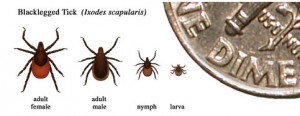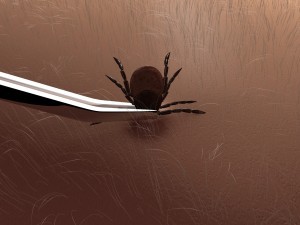I needed some quick advice on ticks. So I went to NYS IPM’s tick webpage and saw — oops. This page is due for a makeover. Now.
Why? Conventional wisdom has it that a (so-called) deer tick needs to be attached to its host for at least 24 hours before it can transmit Lyme disease. (We’ll acknowledge the co-infections later.) Only … conventional wisdom is wrong. Now the best we can say is … no one knows. It varies. The main thing is to get the tick off asap. Just keep in mind that a rush job isn’t necessarily in your best interests. Better to remove it carefully than to remove it too quickly.

The other little problem? Back in the day, biologists thought there were two related tick species: the blacklegged tick and the recently discovered deer tick. But turns out they’re one and the same, so biologists reverted to the old name. Folks: we proudly bring you the (drum roll) blacklegged tick.
Back to removal. Some people swear by “tick tornados.” (Look them up.) And yes — if you need to get a tick off a furry animal, by all means. But for us hairless humans, at IPM (short for “integrated pest management) we still recommend pointy, fine-tipped tweezers as the best way to remove ticks without ticking them off. Enlist help if you can’t reach the tick. Your helper, after all, might need someone to return the favor down the line.
That folklore about gooping them up with petroleum jelly or snubbing out a lit match on their buts? It’s not only folklore — it’s dangerous. Because next thing you know they’ve vomited everything that was in their stomach into your bloodstream.
In a panic? Scraping at them with your fingernail and decapitating them … same result.

So here’s what you do. Use fine-tipped tweezers to grasp the tick as close to the skin’s surface as possible. Pull upward with steady, even pressure. Try not to twist or jerk the bugger; it’s tricky enough getting the head and mouth-parts out as it is.
But if they break off? Not to worry. After all, you got the all-important abdomen off; that’s where the toxins are. So see if you can tug the head out with your tweezers. Can’t? Swab the site with rubbing alcohol (which you’d do in any case) and leave it be. Eventually they’ll come out as your skin regenerates itself from below.
Actually, the main thing is to prevent the tick getting on you in the first place. (Prevention is key to good IPM, right? Right.) Use repellents and permethrin-infused clothing. While outside, check your legs and arms periodically to see if any critters are climbing up. Shower after you come in.
Most important? The daily tick check. Make it check part of your evening routine — floss, brush teeth, tick check.
I promised to acknowledge those co-infections. Right now it’s just this simple list: anaplasmosis, babesia, bartonella. (Can ticks actually transmit bartonella? Unclear. Also: you might find ehrlichiosis listed in online site. It’s actually a complex of several different bacterial diseases. One is anaplasmosis. This stuff gets complicated fast. Which is why I’ll get to the details in another post.)
And yes, there’s lots more tick-borne diseases, but to our knowledge here at IPM, blacklegged ticks don’t carry them. That promised post, btw, will note not just characteristics of these diseases, but list diseases carried by other types of ticks.
Closing remarks: Best reason for ditching the name “deer tick”? It suggests that deer are the problem. Well, yes, ticks do infest deer, and deer can travel widely, so yes, they carry them around in the literal sense and ticks will drop off here and there. But no, deer don’t vector (aka “carry”) Lyme disease. Look to mice, chipmunks, and shrews for that.